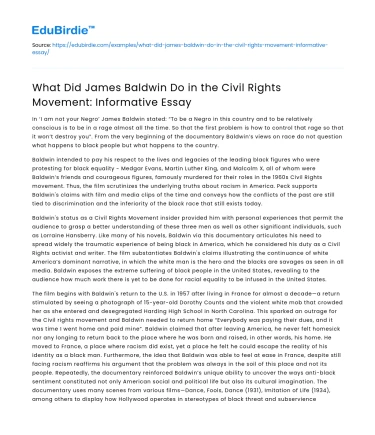In ‘I am not your Negro’ James Baldwin stated: “To be a Negro in this country and to be relatively conscious is to be in a rage almost all the time. So that the first problem is how to control that rage so that it won’t destroy you”. From the very beginning of the documentary Baldwin’s views on race do not question what happens to black people but what happens to the country.
Baldwin intended to pay his respect to the lives and legacies of the leading black figures who were protesting for black equality - Medgar Evans, Martin Luther King, and Malcolm X, all of whom were Baldwin’s friends and courageous figures, famously murdered for their roles in the 1960s Civil Rights movement. Thus, the film scrutinizes the underlying truths about racism in America. Peck supports Baldwin's claims with film and media clips of the time and conveys how the conflicts of the past are still tied to discrimination and the inferiority of the black race that still exists today.
Save your time!
We can take care of your essay
- Proper editing and formatting
- Free revision, title page, and bibliography
- Flexible prices and money-back guarantee
Baldwin's status as a Civil Rights Movement insider provided him with personal experiences that permit the audience to grasp a better understanding of these three men as well as other significant individuals, such as Lorraine Hansberry. Like many of his novels, Baldwin via this documentary articulates his need to spread widely the traumatic experience of being black in America, which he considered his duty as a Civil Rights activist and writer. The film substantiates Baldwin's claims illustrating the continuance of white America’s dominant narrative, in which the white man is the hero and the blacks are savages as seen in all media. Baldwin exposes the extreme suffering of black people in the United States, revealing to the audience how much work there is yet to be done for racial equality to be infused in the United States.
The film begins with Baldwin's return to the U.S. in 1957 after living in France for almost a decade—a return stimulated by seeing a photograph of 15-year-old Dorothy Counts and the violent white mob that crowded her as she entered and desegregated Harding High School in North Carolina. This sparked an outrage for the Civil rights movement and Baldwin needed to return home “Everybody was paying their dues, and it was time I went home and paid mine”. Baldwin claimed that after leaving America, he never felt homesick nor any longing to return back to the place where he was born and raised, in other words, his home. He moved to France, a place where racism did exist, yet a place he felt he could escape the reality of his identity as a black man. Furthermore, the idea that Baldwin was able to feel at ease in France, despite still facing racism reaffirms his argument that the problem was always in the soil of this place and not its people. Repeatedly, the documentary reinforced Baldwin’s unique ability to uncover the ways anti-black sentiment constituted not only American social and political life but also its cultural imagination. The documentary uses many scenes from various films—Dance, Fools, Dance (1931), Imitation of Life (1934), among others to display how Hollywood operates in stereotypes of black threat and subservience as foils for white innocence.
However, as much a documentary about American life in the 1960s it also uses Baldwin’s views to illuminate the link to the contemporary reality of today. The movie’s most integral scenes include footage of police brutality directed against black people in the ’60s and shots of similar violence that takes place today, using Baldwin’s words to depict the distance between the two eras. The juxtaposition highlights the uncanny similarity between the series of black deaths that were perpetrated throughout Baldwin’s life during the civil-rights era, and the series of deaths—of Aiyana Jones, Trayvon Martin, and Eric Garner, to name a few —that mark our own calendar.
Furthermore, a crucial aspect of Baldwin's life is avoided in this film: his sexuality. There is a mention of an FBI file stating that he’s possibly a homosexual, but there is no mention of his queerness. Baldwin’s sexuality was as much a part of his canniness as his blackness; so, while the film remains a powerful statement about race, a key element of his life that may have contributed to his alienation from society is missed. To conclude, the film conveys how deeply Baldwin's words resonate today reinforcing, as the film argues, how this nation fails to heed at its continued peril.






 Stuck on your essay?
Stuck on your essay?

